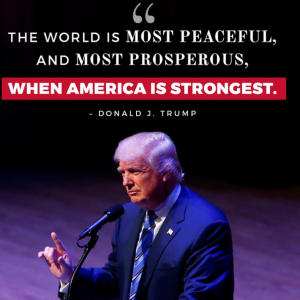A nation must think before it acts.
American presidential election campaigns, for all their pageantry and constantly increasing length, are generally predictable affairs. Although the print and electronic media will trace every slight variation in public sentiment, and the final vote count may be the source of election night drama, every presidential election since 1948 has been won by the person who led in the national polls by late October. This year, however, proved to be something else entirely. As perhaps befits the two main competitors—the first woman ever to be nominated by a major party, and the first major party nominee who had never held major elected or appointed office—this election was indeed historic. When the votes were in early in the morning of November 9, Donald Trump appeared to have won a significant victory over former Secretary of state Hillary Clinton.
Considering the demographic factors that favored Democrats, the divisions within Trump’s party, and his uniquely problematic style, Trump’s victory not only shocked many on election night, but continues to infuriate and befuddle. It’s not surprising that some Clinton diehards see malign forces at work and are pursuing claims of electronic skullduggery by Russian intelligence or vote suppression by conservative officials. At this writing, debates still rage over the specific vote counts in particular places, and over whether the result suggests the need for fundamental reform of how the United States elects its President. Nevertheless, Donald Trump and his transition team are busily assembling his Cabinet and he is preparing to take the oath of office as the forty-fifth president of the United States on January 20, 2017.
There have already been many attempts to divine the deeper meaning of Donald Trump’s rise to the presidency, as well to predict what he might end up accomplishing while in office. There will undoubtedly be many more. Even though the author has made his share of contributions of those genres, this essay is different. Its aim is to examine the possible reasons for Trump’s victory—not necessarily from looking deep into the American soul, but by trying to tease out the tangible political factors that made it possible for a celebrity billionaire with no government experience to be elected to the most powerful positon in the free world.
To start with the most obvious point, which nonetheless requires some explanation, Donald Trump has been elected president because he managed to collect a majority of votes in the Electoral College. This is true even though Hillary Clinton will likely finish with an overall lead of 2 million popular votes once all the ballots have been formally counted. This exposes what can most charitably called a constitutional particularity in the United States, one that is almost as confusing to Americans as it is to outsiders. We do not elect the president based on a straight popular vote (as they do in countries such as France). Rather, the presidential campaign ends up as fifty-one separate popular votes—in the fifty states and the District of Columbia. In each of those separate votes (with two minor exceptions in Nebraska and Maine) the winner of the state’s popular vote receives all of that state’s electoral votes. The total number of electoral votes in the Electoral College equals the total number of members of the House of Representatives (435) and the Senate (100), plus three for the District of Columbia—that is, 538. The candidate who wins enough states to earn 270 electoral votes becomes president.




